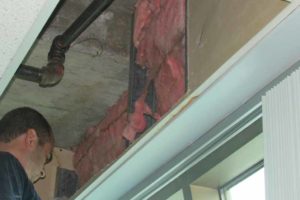Condensation on curtain wall surfaces: An investigation

Mitigation strategies
As an initial mitigation strategy, several measures were proposed to the building management to minimize the formation of condensation at the building corners in extreme cold. These changes were applied to areas of a test floor. The following modifications, repairs, or adjustments were employed due to ease of implementation and relatively low cost:
- Verification of humidity sensors within the air returns for proper operation and recalibration where necessary.
- Modification to HVAC controls’ humidification schedules. During occupied periods, humidification was reduced in a gradual fashion from the nominal level (30 per cent RH at –10 C [14 F] exterior temperature) to 25 per cent RH at –15 C (5 F) or colder exterior temperature. The proposed reduction in humidification decreased the dewpoint temperature of the conditioned air from approximately 4 to 1 C (39.2 to 33.8 F) without major impact to comfort levels. Humidification remained non-operational during unoccupied periods.
- Keeping ventilation and perimeter heating systems in operation for exterior temperatures at or below –15 C during unoccupied periods and in vacant spaces. As an energy conservation measure, dampers for exterior fresh air make-up restricted air supply.
- Verification and repair of existing perimeter heating systems where necessary.
- Installation of supplemental perimeter heaters in areas where units were noted to be absent.
Due to high costs, a series of modifications proposed for the perimeter ventilation system to improve airflow around structural columns (through the installation of linear diffusers) were not implemented. The option was, however, retained as a last-resort measure if initial attempts proved insufficient to significantly improve condensation resistance at building corners.
Interim results
Following the implementation of these initial changes on a test floor, the corner office spaces on that level were reviewed regularly during periods of cold weather to verify their effectiveness. During these site visits, thermal scans and surface temperature measurements of curtain wall interior surfaces were recorded.
An increase in interior curtain wall surface temperatures was observed. In some instances, localized condensation was still noted and some accumulation had occurred on sills of some of the offices of the test floor. In these cases, the perimeter heaters were marginally operational due to a low thermostat setting (set by the occupant of the office space).
Temperature measurements indicated the effect of installing supplemental heaters at building corners produced an increase in interior curtain wall surface temperatures of approximately 2.5 C (4.5 F) near the sills of vision areas (with an exterior temperature of approximately –18 C [–0.4 F]). Significantly higher temperatures were observed near the head of vision areas. Although initial efforts produced positive results with a marked reduction in surface condensation, estimates of projected interior surface temperatures for colder exterior temperatures still indicated additional improvements were required.
For interior air conditioned to 22 C (71.6 F) and 25 per cent RH (reduced from 30 per cent RH), surface temperatures significantly in excess of the dewpoint temperature (approximately 1 C [33.8 F]) would be required during periods of extreme cold to provide sufficient margin against the formation of condensation on interior surfaces.
Additional investigations
Prior to revisiting considerations for the modification of perimeter ventilation systems for additional temperature gains (or other exotic and equally expensive alternatives), some exploratory dismantling was performed within the cavity wall finish below sill level (within a corner space on an unoccupied floor) to examine the spandrel area of the curtain wall assembly.
Subsequent observations indicated a layer of batt insulation measuring approximately 152 mm (6 in.) in thickness had been installed within the cavity space between the curtain wall insulated pan and the interior drywall finish. A similar condition was also confirmed to exist within the suspended ceiling space at the junction of the curtain wall and overhead slab (Figure 6).
The installation of batt insulation within the cavity space of the interior finishes was subsequently analyzed to determine its impact on curtain wall condensation resistance.





